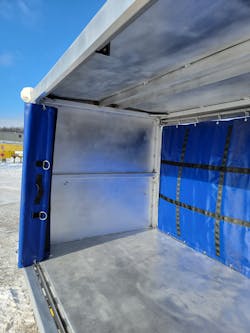Aluminum’s Benefit to Baggage Handling
With an eye on reducing its environmental impact, Wilcox GSE began manufacturing aluminum baggage carts two years ago. In addition to environmental benefits, the aluminum carts weigh less and can reduce the cost to operate and maintain the equipment.
“The inspiration behind that aluminum baggage cart came from the need for all of us to help combat global warming,” says David Dick, vice president at Wilcox GSE. “It is our responsibility as a company to design products which not only reduce our carbon footprint during the manufacturing process but as well as the carbon footprints of our customers using the product.”
Available in two models – a closed baggage cart and an open baggage cart – the main structure of the cart, including the floor, sides and roof, are all manufactured from previously recycled aluminum.
“The cart is left in its natural aluminum state and not painted,” he adds, noting the carts can be purchased with non-reinforced or reinforced side curtains in a variety of colors.
According to Dick, no paint is needed because aluminum does not rust. As a result, no volatile organic components (VOCs) are released into the environment from the painting/powdercoating process.
“There will be no scratched paint, there will be no rusting floor or sides,” Dick says. “They will virtually always look new and fresh. The passengers in the aircrafts or terminals will look out and see clean fresh baggage carts loading the planes.”
Wilcox GSE’s closed baggage cart is 5 feet by 10 feet and fully enclosed with curtains on both sides of the cart, while the open baggage cart is 5 feet by 10 feet and half height sides on both ends of the cart.
Utilizing a tubular structural design, additional features of the aluminum baggage carts include a peaked roof with drip rails to channel water to the ends of the cart; top corner bumpers; outside rub rail bumpers; and e-hitch. The closed cart baggage cart includes an anti-lock curtain rail system.
Since the aluminum baggage carts were initially designed, officials at Wilcox GSE have changed the initial rear axle from aluminum to steel and added rubber shock absorbers between the axles and the main structure.
“This design change was to reduce road vibration, reducing the wear and tear on the overall structure,” says Dick. “By bolting the axles into place, it allows for very quick axle repairs if needed. Continuous improvement remains one of the most important factors of our quality and product development.”
Like with its steel carts, Wilcox GSE aluminum baggage carts have an integrated parking lock for when the cart is not in use.
“When the tow-bar is in the up position, the front wheels are locked and the cart cannot move,” Dick says. “Further, for operators, the Wilcox GSE Aluminum Baggage Cart is 500 pounds lighter than the Wilcox GSE steel baggage cart. With the lighter weight, they are easier and safer to manually move.”
Advantages of the lighter weight carts include reduced fuel usage of the tractor and less wear on tires.
“Over the lifespan of the unit, the operating cost will be lower when using aluminum baggage carts. Tires will last longer, hubs will last longer, they will never need to be repainted,” Dick says. “When it comes time for the cart retirement, the cart can be sent to be recycled and turned into another new product.”
Aluminum baggage carts won’t be for everyone, according to Dick. However, he says ground handlers and airline personnel who are in high salt level areas – near oceans, in cold climates, etc. – may benefit more. Currently Wilcox GSE has carts being used in Salt Lake City and Toronto with more units destined for Alaska in the near future.
“The operators love them, and the companies love how they continue to look new after many uses,” says Dick.
“It’s important for us all to do what we can to help the environment – to make green choices,” he adds. “Utilizing baggage carts manufactured from aluminum is a step to reduce your carbon footprint.”
About the Author
Josh Smith
Editor
Josh Smith served as editor of Ground Support Worldwide as editor from 2016 through 2024. He oversaw production of the print magazine, created GSW's newsletters on a daily basis, and updated the latest news on AviationPros.com.

